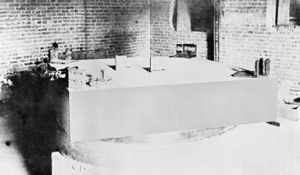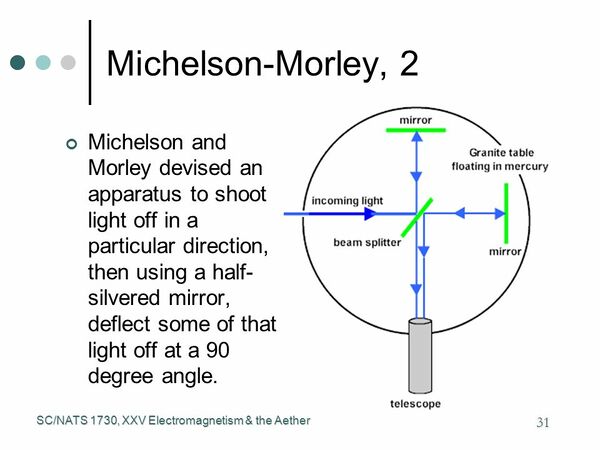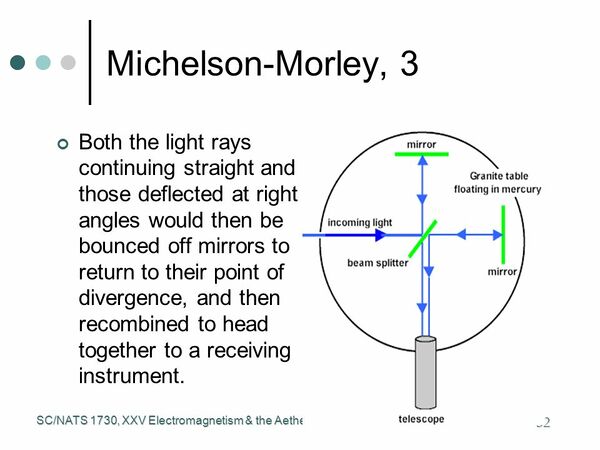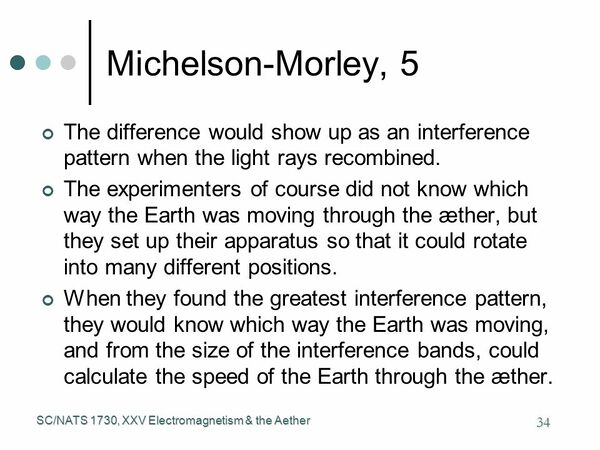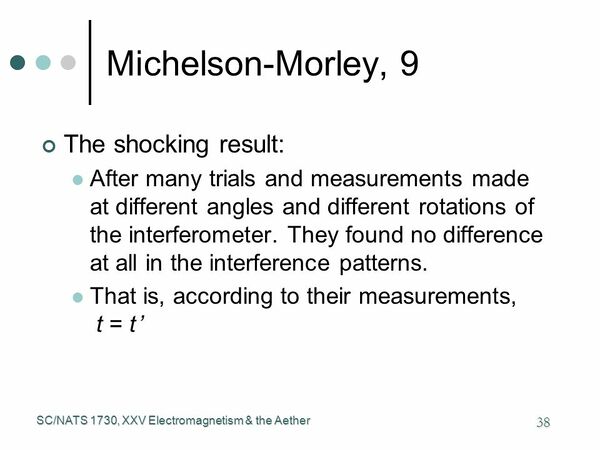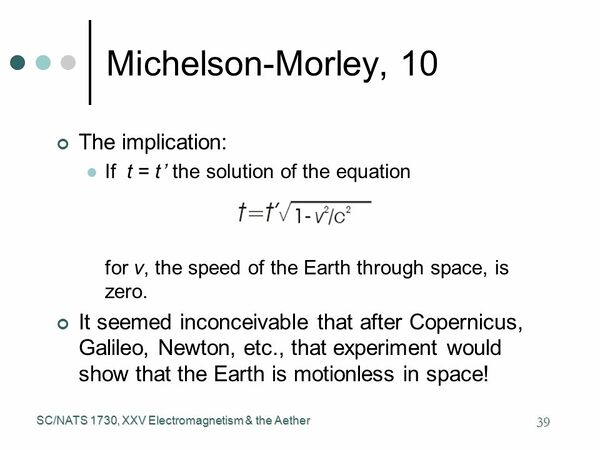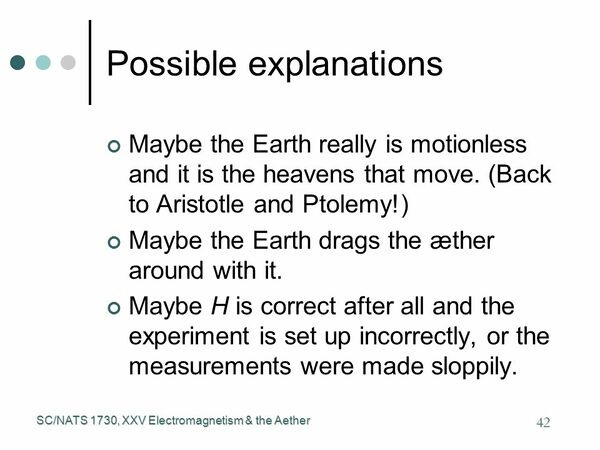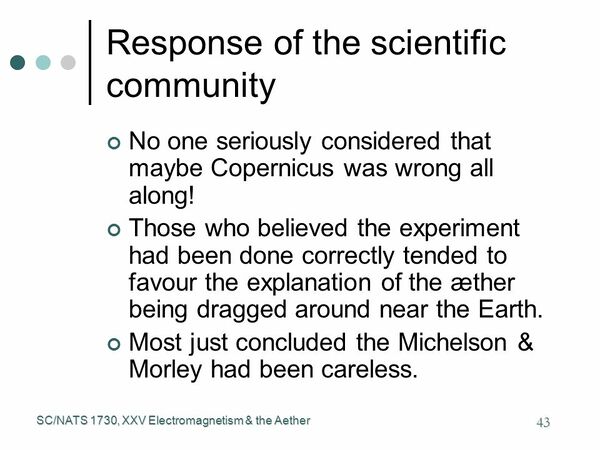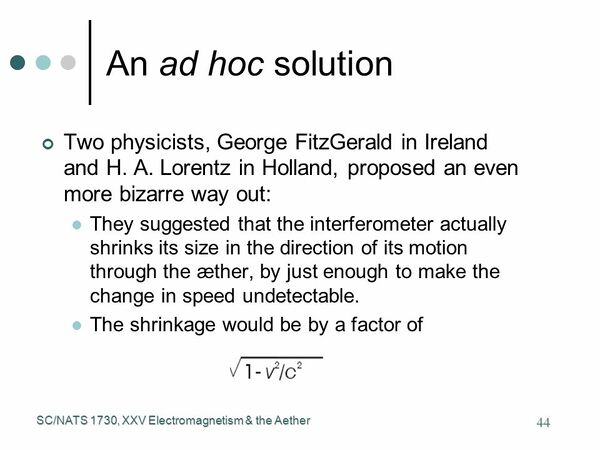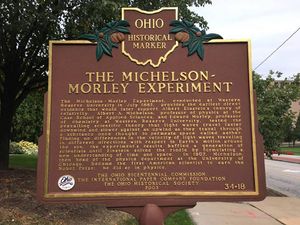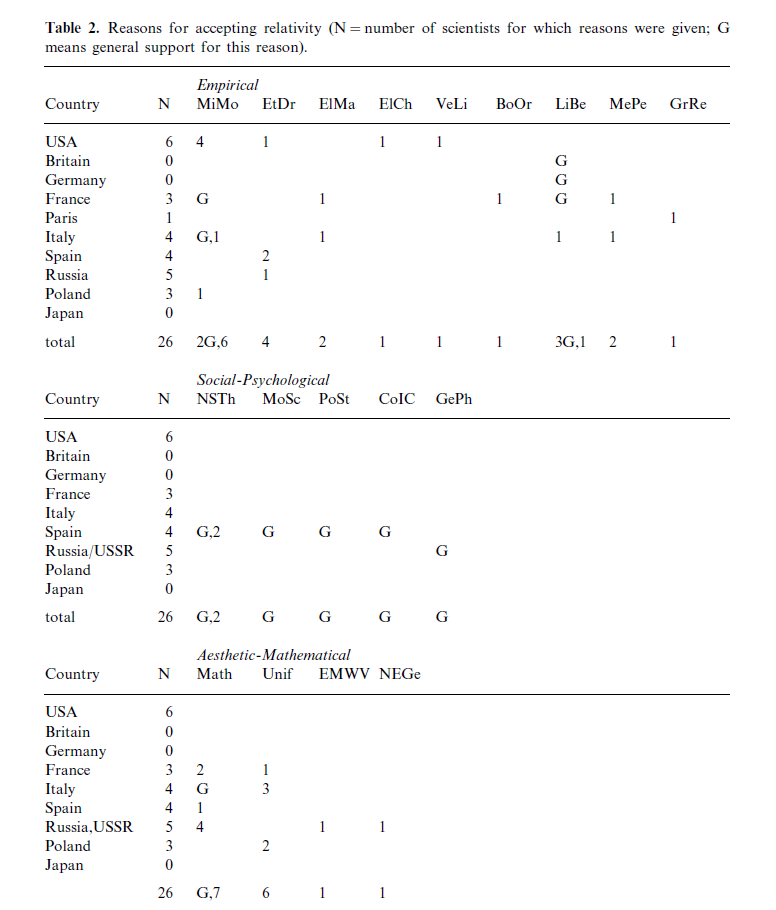Difference between revisions of "Michelson-Morley Experiment"
Tom Bishop (talk | contribs) |
Tom Bishop (talk | contribs) (→Quotes) |
||
| (228 intermediate revisions by 3 users not shown) | |||
| Line 1: | Line 1: | ||
| − | The Michelson–Morley experiment was first performed in 1887 by Albert A. Michelson and Edward W. Morley. | + | [[File:Michelson-Morley-Equipment.jpg|thumb|The Michelson–Morley Experiment]]The '''Michelson–Morley experiment''' was an experiment designed to test the velocity of light that was first performed in 1887 by Albert A. Michelson and Edward W. Morley. Unfortunately, a number of writers on this topic tend to gloss over, or sometimes mischaracterize, what this experiment demonstrated, its significance, and how it was a turning point in science which necessitated the adoption of a radically different and alternative model of space. |
| − | + | At the time it was held that in order for light to travel through space it was necessary that there was a medium filling the void through which it could propagate, much like how sound waves travel through the air or ripples through water. This background medium of space was colloquially known as 'aether' (See: [[Aether]]). | |
| − | The | + | The goal of the Michelson–Morley experiment was to compare the speed of light in perpendicular horizontal directions at various times of the day, in an attempt to detect the relative motion of matter through the stationary luminiferous aether by using the earth's motion around the sun to create interference bands of light for the study. Morley wrote to his father that the purpose of the experiment was “to see if light travels with the same velocity in all directions.”<sup>1</sup> |
| − | + | The shocking result of this experiment is that light did travel with the same velocity in the various horizontal directions tested. The earth did not measurably move around the sun at all, in contradiction to all expectations and the accepted astronomical model. Michelson and Morley found that a light beam discharged horizontally in the direction of the Earth’s assumed motion showed virtually no difference in speed from a light beam discharged north to south or south to north. In other words, the experiment failed to detect the Earth moving in or against space, of whatever space was understood to consist. | |
| − | "Although repeated over the next 40 years with ever greater precision and the same negative result, this 1887 experiment is pointed to as one of the experimental foundations of relativity, and earned Michelson the Nobel Prize in 1907. | + | After the famous Michelson-Morley experiment of 1887, one of Albert Einstein's biographers, Ronald W. Clark, describes what came next: |
| + | |||
| + | {{cite|The problem which now faced science was considerable. For there seemed to be only three alternatives. The first | ||
| + | was that the Earth was standing still, which meant scuttling the whole Copernican theory and was ''unthinkable''. <sup>2</sup>}} | ||
| + | |||
| + | Michelson and Morley and later scientists repeated the experiment many times, and in many different horizontal axial positions and configurations, at different times of the day, all with a null result. The earth was seen to be motionless. The experiment has been referred to as "the moving-off point for the theoretical aspects of the Second Scientific Revolution"<sup>3</sup> and directly influenced the creation of Albert Einstein's Theory of Special Relativity. | ||
| + | |||
| + | The Theory of Special Relativity subsequently found favor among scientific circles because the second postulate of Special Relativity provided an illusion where the velocity of light is constant to all observers regardless of motion, and seemingly explained the motionless earth result of the Michelson-Morley experiment. This fundamental change to the nature of space and time allowed the theory of the earth's motion around the sun to survive direct contradicting experimental evidence and encouraged, perhaps forced, its adoption as the accepted model of space for Heliocentrism. | ||
| + | |||
| + | G.J. Whitrow, a British mathematician, cosmologist, and science historian, characterized the Michaelson-Morley experiment from a historical perspective: | ||
| + | |||
| + | {{cite|if such an experiment could have been performed in the sixteenth or seventeenth [centuries] when men were debating the rival merits of the Copernican and Ptolemaic systems. The result would surely have been interpreted as conclusive evidence for the immobility of the Earth, and therefore as a triumphant vindication of the Ptolemaic system and irrefutable falsification of the Copernican hypothesis.<sup>4</sup>}} | ||
| + | |||
| + | ''Footnotes'' | ||
| + | |||
| + | :<sup>1</sup> Letter dated April 17, 1887, in the Edward W. Morley Papers, Library of Congress, as cited in Dorothy Michelson Livingston’s Master of Light: A Biography of :Albert Michelson, New York, Charles Scribner, 1973, p.126.<br> | ||
| + | :<sup>2</sup> Einstein: The Life and Times, Avon Book, New York, NY, 1984, p. 109-110.<br> | ||
| + | :<sup>3</sup> Hoover, Earl R. (1977). Cradle of greatness : national and world achievements of Ohio's Western Reserve<br> | ||
| + | :<sup>4</sup> G. J. Whitrow, The Structure and Evolution of the Universe, New York, Harper and Brothers Publishers, 1959, p. 79.<br> | ||
| + | |||
| + | http://hyperphysics.phy-astr.gsu.edu/hbase/Relativ/mmhist.html ([https://web.archive.org/web/20181114011753/http://hyperphysics.phy-astr.gsu.edu/hbase/Relativ/mmhist.html Archive]) | ||
| + | |||
| + | {{cite|Although repeated over the next 40 years with ever greater precision and the same negative result, this 1887 experiment is pointed to as one of the experimental foundations of relativity, and earned Michelson the Nobel Prize in 1907.}} | ||
=Description and Result= | =Description and Result= | ||
| − | Material from a York University course provides a good summary of the Michelson-Morley experiment and its result. Below are | + | Material from a York University course by Prof. Byron E. Wall provides a good summary of the Michelson-Morley experiment and its result. Below are slides that tell the story. Interested readers should feel free to go through the entire slide deck. |
| + | |||
| + | [https://www.yorku.ca/bwall/nats1730/summer2011/1730-summer11-courseoutline.pdf Course Description] ([https://web.archive.org/web/20181106185812/https://www.yorku.ca/bwall/nats1730/summer2011/1730-summer11-courseoutline.pdf Archive])<br> | ||
| + | [https://slideplayer.com/slide/7912445/ Full Slideshow] ([https://web.archive.org/web/20181106190218/http://player.slideplayer.com/download/25/7912445/Qx-wZX0EvtDsykRVayu61Q/1541534448/7912445.ppt .ppt Archive]) | ||
| + | |||
| + | [[File:MM-Slide-31.jpg|600px]] | ||
| + | [[File:MM-Slide-32.jpg|600px]] | ||
| + | [[File:MM-Slide-34.jpg|600px]] | ||
| + | [[File:MM-Slide-38.jpg|600px]] | ||
| + | [[File:MM-Slide-39.jpg|600px]] | ||
| + | [[File:MM-Slide-42.jpg|600px]] | ||
| + | [[File:MM-Slide-43.jpg|600px]] | ||
| + | [[File:MM-Slide-44.jpg|600px]] | ||
| + | |||
| + | Note: Aether Drag Hypothesis was later rejected as a possibility because it was incompatible with the [[Sagnac Experiment]] and [[Airy's Failure]]. See the [https://en.wikipedia.org/wiki/Aether_drag_hypothesis Aether drag hypothesis] Wikipedia article. | ||
| + | |||
| + | ==Lorentz–FitzGerald Contraction== | ||
| + | |||
| + | The Lorentz–FitzGerald Contraction, also known as the Lorentz Contraction, was supported by Einstein and became a part of Special Relativity. | ||
| + | |||
| + | {{cite|Although the estimated difference between these two times is exceedingly small, Michelson and Morley performed an experiment involving interference in which this difference should have been clearly detectable. But the experiment gave a negative result — a fact very perplexing to physicists. Lorentz and FitzGerald rescued the theory from this difficulty by assuming that the motion of the body relative to the æther produces a contraction of the body in the direction of motion, the amount of contraction being just sufficient to compensate for the difference in time mentioned above.}} — Albert Einstein, 1916 | ||
| + | |||
| + | {{cite|Lorentz-FitzGerald contraction, also called space contraction, in relativity physics, the shortening of an object along the direction of its motion relative to an observer. Dimensions in other directions are not contracted.}} — [https://web.archive.org/web/20211218102252/https://www.britannica.com/science/Lorentz-FitzGerald-contraction Encyclopedia Britannica] | ||
| − | [https:// | + | {{cite|One of the peculiar aspects of Einstein's theory of special relativity is that the length of objects moving at relativistic speeds undergoes a contraction along the dimension of motion. An observer at rest (relative to the moving object) would observe the moving object to be shorter in length.}} — [https://web.archive.org/web/20211114053226/https://www.physicsclassroom.com/mmedia/specrel/lc.cfm Physicsclassroom.com] |
| − | |||
| − | + | {{cite|The ether-drift experiment was expected to show a displacement of about 0.4 fringe when the interferometer was rotated through 90°, but the displacements were certainly not more than 0.01 of a fringe. As is well known, the negative character of their results was largely responsible for the development of the theory of relativity, by Lorentz, Fitzgerald, Einstein, and others.}} — ''"Albert A. Michelson,"'' [http://adsabs.harvard.edu/full/1931ApJ....74....1G The Astrophysical Journal, July 1931, p.4] | |
| − | [ | ||
| − | |||
| − | |||
| − | |||
| − | |||
| − | |||
=Peer Reviews and Repetitions= | =Peer Reviews and Repetitions= | ||
| − | Since 1887 the Michelson-Morley experiment has been repeated and verified on a | + | Since 1887 the Michelson-Morley experiment has been repeated and verified on many occasions, with several different methodologies. The [https://en.wikipedia.org/wiki/Michelson%E2%80%93Morley_experiment#Subsequent_experiments Michelson-Morley Wikipedia article] ([http://archive.fo/pSMs3 Archive]) maintains a list of subsequent experiments. |
| + | |||
| + | A 2009 repetition of the experiment is described below: | ||
==2009 Repetition in Germany== | ==2009 Repetition in Germany== | ||
| − | https://physicsworld.com/a/michelson-morley-experiment-is-best-yet/ | + | https://physicsworld.com/a/michelson-morley-experiment-is-best-yet/ ([https://web.archive.org/web/20181114011552/https://physicsworld.com/a/michelson-morley-experiment-is-best-yet/ Archive]) |
'''Michelson–Morley experiment is best yet''' | '''Michelson–Morley experiment is best yet''' | ||
| − | + | {{cite|Physicists in Germany have performed the most precise Michelson-Morley experiment to date, ''confirming that the speed of light is the same in all directions''. The experiment, which involves rotating two optical cavities, is about 10 times more precise than previous experiments – and a hundred million times more precise than Michelson and Morley’s 1887 measurement.}} | |
| + | |||
| + | =Influence of the MiMo Experiment on Relativity= | ||
| + | |||
| + | In a lecture titled ''[https://artsandculture.google.com/exhibit/QQpRfXM- How I Created the Theory of Relativity]'' ([https://web.archive.org/web/20181114011456/https://artsandculture.google.com/exhibit/QQpRfXM- Archive]) Albert Einstein points this experiment out as a basis on developing Special Relativity: | ||
| + | |||
| + | {{cite|I was familiar with the strange results of Michelson’s experiment while I was still a student pondering these problems, and instinctively realized that, if we accepted his result as a fact, it would be wrong to think of the motion of the Earth with respect to the ether. This insight actually provided the first route that led me to what we now call the principle of special relativity. I have since come to believe that, although the Earth revolves around the Sun, its motion cannot be ascertained through experiments using light.}} | ||
| + | |||
| + | Einstein also mentions in regards to SR: "I also started to work on the problem of Fizeau’s experiment and tried to account for it," which is another light velocity experiment. | ||
| + | |||
| + | In ''The Intrinsic Nature of Things: The Life and Science of Cornelius Lanczos'', Barbara Gellai [https://books.google.com/books?id=kEjeQwNSIpoC&lpg=PA14&pg=PA14#v=onepage&q&f=false describes on p.14] ([https://web.archive.org/web/20210201190617/https://books.google.com/books?id=kEjeQwNSIpoC&lpg=PA14&pg=PA14#v=onepage&q&f=false Archive]): | ||
| − | + | {{cite| To solve the paradox of the Michelson-Morley experiment we have to abandon Newton's axioms of absolute space and absolute time. Einstein solved the problem by making the ingenious assumption that observers moving with different velocities with respect to each other have their own space and time. The second postulate of the theory of relativity is that light propagates in every direction with the same constant velocity, in every legitimate (uniformly moving) reference system. It is actually the theoretical formulation of the negative result of Michelson and Morley's experiment.}} | |
| − | ==Why | + | ==Historical Marker== |
| + | |||
| + | [[File:MM-Historical-Marker.jpg|thumb|Michelson-Morley Historical Marker]] | ||
| + | In Cleveland, Ohio, there is a Michelson-Morley Historical Marker located just outside the science building on the Case Western Reserve University campus which provides the following: | ||
| + | |||
| + | {{cite|The Michelson-Morley Experiment, conducted at the Western Reserve University in July 1887, provides the earliest direct evidence that would later support Albert Einstein's theory of relativity. Albert A. Michelson, professor of physics at the Case School of Applied Sciences, and Edward Morley, professor of chemistry at Western Reserve University, tested the prevailing scientific theory that light waves travel faster downwind and slower against an upwind as they travel faster through a substance once thought to permeate space called aether. Finding no differences in the velocity of light waves traveling in different directions with respect to Earth's motion around the sun, the experiment's results baffled a generation of scientists until Einstein solved the riddle by formulating a new understanding of time and space. In 1907, Michelson, then head of the physics department at the University of Chicago, became the first American scientist to earn the Nobel Prize: he did so in physics.}} | ||
| + | |||
| + | The marker describes that, when science was confronted with direct evidence of an earth without motion around the sun, an entirely new model of space and time was required to explain it. | ||
| + | |||
| + | ==Why Relativity Was Accepted== | ||
'''Why Was Relativity Accepted?'''<br> | '''Why Was Relativity Accepted?'''<br> | ||
By Stephen G. Brush | By Stephen G. Brush | ||
| − | http://citeseerx.ist.psu.edu/viewdoc/download?doi=10.1.1.535.1670&rep=rep1&type=pdf | + | Full Text: http://citeseerx.ist.psu.edu/viewdoc/download?doi=10.1.1.535.1670&rep=rep1&type=pdf ([https://web.archive.org/web/20181114011422/http://citeseerx.ist.psu.edu/viewdoc/download?doi=10.1.1.535.1670&rep=rep1&type=pdf Archive)] |
| − | An interesting analysis on why Relativity was accepted in science. The author concludes that much of why it was accepted is because it was a world-model which purported to explain the Michelson-Morley experimental result of a | + | An interesting analysis on why Relativity was accepted in science. The author concludes that much of why it was accepted is because it was a world-model which purported to explain the Michelson-Morley experimental result of a motionless earth. Another top reason was because of an underlying desire for a unified, elegant physical theory. |
| − | The author provides quotes by the scientists of the day identifying the Michelson- | + | The author provides quotes by the scientists of the day, identifying the Michelson-Morley null result as a primary factor. |
===Remarks by Prominent Physicists=== | ===Remarks by Prominent Physicists=== | ||
| − | + | {{cite|José Sánchez-Ron [a prominent Spanish physicist] suggests that G.A. Schott and other British physicists were interested in relativity because it offered a way to deal with problems arising from the new atomic physics, in which the magnetic interactions of electrons and their behavior at very high speeds needed to be better understood. | |
| − | + | Sánchez-Ron also points to the interest of these physicists in symmetry considerations. But the most explicit statement he quotes about the reason for accepting relativity is that of an anonymous reviewer of Ludwik Silberstein’s 1914 book: "without the result of Michelson and Morley’s experiment there would be no justification for the theory at all... [It] will only be when further experimental data of a crucial kind are obtained that the theory will run much chance of becoming definitely accepted as scientific knowledge." }} | |
| − | + | {{cite|In 1907, K.K. Baumgart supported the ‘Lorentz-Einstein theory’ because it was compatible with the negative result of the Michelson-Morley experiment}} | |
| − | + | {{cite|Dirac [a famous English theoretical physicist] stated that he first learned about relativity theory when it was widely publicized in England after World War I by Eddington. His initial interest in the theory was captured by the experimental evidence – Michelson-Morley experiment, Mercury’s orbit, and light bending.}} | |
| − | + | {{cite|Langevin [a famous French physicist] tried to persuade the Collège de France to invite Einstein to lecture in Paris, and finally succeeded in 1922; the result was a flurry of popular interest in relativity. After Einstein’s visit Langevin decided that relativity is supported by experiments such as that of Michelson and Morley.}} | |
===Statistical Tables=== | ===Statistical Tables=== | ||
| − | The author provides three statistical analysis tables for why Relativity was accepted, focusing on ''Empirical | + | The author provides three statistical analysis tables for why Relativity was accepted, focusing on ''Empirical'' reasons, ''Social-Psychological'' reasons, and ''Aesthetic-Mathematical'' reasons. |
[[File:Relativity-Reasons-Table.png]] | [[File:Relativity-Reasons-Table.png]] | ||
| − | '''Abbreviation Reference''' | + | ::'''Abbreviation Reference''' |
| + | :: | ||
| + | ::''Empirical''<br> | ||
| + | ::'''MiMo''' — negative result of Michelson-Morley experiment<br> | ||
| + | ::'''EtDr''' — failure of ether drift experiments<br> | ||
| + | ::'''ElMa''' — variation of electron mass with velocity<br> | ||
| + | ::'''ElCh''' — variation of electron charge with velocity<br> | ||
| + | ::'''VeLi''' — velocity of light from terrestrial and celestial sources is the same<br> | ||
| + | ::'''BoOr''' — correction of orbits and energy levels in Bohr model of atom<br> | ||
| + | ::'''LiBe''' — light-bending observations<br> | ||
| + | ::'''MePe''' — Advance of Mercury Perihelion<br> | ||
| + | ::'''GrRe''' — Gravitational redshift of spectral lines<br> | ||
| + | :: | ||
| + | ::''Social-Psychological''<br> | ||
| + | ::'''NSTh''' — rejection of absolute space and time is consistent with neo-scholastic theology<br> | ||
| + | ::'''MoSc''' — association with ‘‘modern’’ science<br> | ||
| + | ::'''PoSt''' — relativism of political structures, attractive to anti-democratic ideologues<br> | ||
| + | ::'''CoIC''' — acquire prestige for comprehending the incomprehensible<br> | ||
| + | ::'''GePh''' — respect for authority of German physics<br> | ||
| + | :: | ||
| + | ::''Aesthetic-Mathematical''<br> | ||
| + | ::'''Math''' — mathematical aspects of the theory<br> | ||
| + | ::'''Unif''' — desire for a unified, elegant physical theory<br> | ||
| + | ::'''EMWV''' — connection with electromagnetic worldview<br> | ||
| + | ::'''NEGe''' — connection with Lobachevsky’s non-Euclidean geometry<br> | ||
| + | |||
| + | The reader should note that the Michelson-Morley Experiments are a subset of the "failure of the ether drift experiments," which are a larger collection of experiments which have failed to detect earth's motion through space. The Michelson-Morley Experiment is the most known and famous experiment of the collection. | ||
| + | |||
| + | =How Einstein Made the Earth Move= | ||
| + | |||
| + | Video: [https://www.youtube.com/watch?v=q8YKvCLlt0E '''How Einstein Made the Earth Move''']<br> | ||
| + | By Jeran Campanella and Robert Sungenis<br> | ||
| + | |||
| + | {{#ev:youtube|https://www.youtube.com/watch?v=qoo1nnX4yGk}} | ||
| + | |||
| + | Description: "This video is a reading of a PDF written by Robert Sungenis in 2016 called "Albert Einstein: The Earth Mover- How Einstein Made The Earth Move (When All The Experiments Showed It Didn't Move)" This video will challenge you to decide which belief is pseudoscientific... the belief that the Earth moves... or that it stands still." | ||
| + | |||
| + | [https://web.archive.org/web/20190412005126/http://www.theprinciplemovie.com/wp-content/uploads/2016/08/Albert-Einstein-The-Earth-Mover.pdf PDF Direct Link] | ||
| + | |||
| + | =Quotes= | ||
| + | |||
| + | Below are miscellaneous quotes from various physicists and authors on the topic of the Michelson-Morley Experiment.<br><br> | ||
| + | |||
| + | {{cite2|If you haven't given much thought to the implications of twentieth-century science, you may be chagrined...to realize that because of the concept of relative motion, no one can prove that the Earth moves.|Kitty Ferguson, Measuring the Universe, 1999, p. 106, 107}} | ||
| + | |||
| + | {{cite2|We might hope therefore that the Einstein theory, which is well suited to such problems, would throw more light on the matter. But instead of adding further support to the heliocentric picture of the planetary motions, the Einstein theory goes in the opposite direction, giving increased respectability to the geocentric picture|Sir Fred Hoyle, Nicolaus Copernicus: An Essay on His Life and Work, p. 87}} | ||
| + | |||
| + | {{cite2|No physical experiment ever proved that the Earth actually is in motion.|Lincoln Barnett, The Universe and Dr. Einstein, 2nd rev. edition, 1957, p. 73.}} | ||
| + | |||
| + | {{cite2|In the effort to explain the Michelson-Morley experiment...the thought was advanced that the Earth might be stationary.|Creator of the first IQ test - Arthur S. Otis}} | ||
| + | |||
| + | {{cite2|The experiment was tried again by Morley and by others, with the same conclusion; the apparent velocity of the earth through the ether was zero.|Historian Lincoln Barnett, The Universe and Dr. Einstein, p. 44.}} | ||
| + | |||
| + | {{cite2|The easiest explanation was that the earth was fixed in the ether and that everything else in the universe moved with respect to the earth and the ether …Such an idea was not considered seriously|James A. Coleman, Relativity for the Layman, p. 37.}} | ||
| + | |||
| + | {{cite2|The Michelson-Morley experiment confronted scientists with an embarrassing alternative. On the one hand they could scrap the ether theory which had explained so many things about electricity, magnetism, and light. Or if they insisted on retaining the ether they had to abandon the still more venerable Copernican theory that the earth is in motion. To many physicists it seemed almost easier to believe that the earth stood still than that waves – light waves, electromagnetic waves – could exist without a medium to sustain them. It was a serious dilemma and one that split scientific thought for a quarter century. Many new hypotheses were advanced and rejected. The experiment was tried again by Morley and by others, with the same conclusion; the apparent velocity of the earth through the ether was zero.|Historian Lincoln Barnett, foreword by Albert Einstein}} | ||
| + | |||
| + | {{cite2|It could have detected speeds as low as two miles a second instead of the known 20mps that the earth as in its orbital motion around the sun. It didn’t detect it. What’s the conclusion from the Michelson‐Morley experiment? The implication is that the earth is not moving|Professor of Physics Richard Wolfson- “The Teaching Company”, episode taught at Middlebury College.}} | ||
| + | |||
| + | {{cite2|There was just one alternative; the earth's true velocity through space might happen to have been nil.|Arthur Eddington, The Nature of the Physical World, 1929, pp. 11, 8}} | ||
| + | |||
| + | {{cite2|Briefly, everything occurs as if the Earth were at rest, and the relative rays were the absolute rays|Hendrik Lorentz, 1886}} | ||
| + | |||
| + | {{cite2|The data were almost unbelievable… There was only one other possible conclusion to draw — that the Earth was at rest....This, of course, was preposterous|Bernard Jaffe, Michelson and the Speed of Light, 1960, p. 76}} | ||
| + | |||
| + | {{cite2|Thus, even now, three and a half centuries after Galileo...it is still remarkably difficult to say categorically whether the earth moves...|Physicist, Julian B. Barbour}} | ||
| + | |||
| + | {{cite2|Always the speed of light was precisely the same…Thus, failure [of Michelson-Morley] to observe different speeds of light at different times of the year suggested that the Earth must be ‘at rest’…It was therefore the ‘preferred’ frame for measuring absolute motion in space. Yet we have known since Galileo that the Earth is not the center of the universe. Why should it be at rest in space?|Adolf Baker, Modern Physics & Antiphysics, pp. 53-54 (Addison-Wesley, 1972).}} | ||
| + | |||
| + | {{cite2|The Michelson-Morley experiment has thus failed to detect our motion through the aether, because the effect looked for – the delay of one of the light waves – is exactly compensated by an automatic contraction of the matter forming the apparatus.|Sir Arthur Eddington, Space, Time and Gravitation, p. 20}} | ||
| + | |||
| + | {{cite2|But no one wanted to go back to before Copernicus, to a geocentric view, or conclude from the Michelson-Morley experiment that the Earth was resting motionless in the ether. Instead, brilliant theories were designed to prove that it was impossible to observe a movement relative to the ether. In these endeavors the theory of Hendrik Antoon Lorentz offered the most valuable insights|Albrecht Fölsing, Albert Einstein: A Biography, p.160}} | ||
| + | |||
| + | {{cite2|The explanation which had the most appeal in accounting for the negative result of the Michelson-Morley experiment was one that was literally dreamed up for the purpose. It is the so-called Fitzgerald-Lorentz contraction. In 1893 Fitzgerald suggested that all objects contracted in the direction of their motion through the ether. He reasoned that if ordinary objects flattened out upon impact with other objects – a rubber ball hitting a wall or a ripe tomato dropped on the floor, for example – then why would it not be possible for objects that move through the ether to have the force of the ether push them in, or contract them? This would adequately explain the results of the Michelson-Morley experiment. The arm of the interferometer moving against the ether would be shortened so that, even though the light wave travelling in that particular arm might be slowed down by the ether wind, this would be compensated for by having its path shortened | ||
| + | |||
| + | ...Objections to the Fitzgerald-Lorentz contraction hypothesis were rampant, as was to be expected, not only because there was no evidence to prove that such an effect took place, but particularly because Fitzgerald could not explain why objects would contract due to motion through the ether. The contraction hypothesis was originally advanced only as a possible explanation for Michelson and Morley’s results, providing such an effect existed. Then, too, the theory said that all materials travelling with the same velocity with respect to the ether would contract the same fractional amount. Since iron is much heavier and stronger than wood, for example, one would expect a greater contraction for wood than for iron, but this, too, went unanswered.|James A. Coleman, Professor of Physics and Chairman of the Department of Physics at the American International College, Spring-field, Massachusetts, "Relativity for the Layman"}} | ||
| + | |||
| + | {{cite2|...to the question whether or not the motion of the Earth in space can be made perceptible in terrestrial experiments. We have already remarked in Section V that all attempts of this nature led to a negative result. Before the theory of relativity was put forward, it was difficult to become reconciled to this negative result.|Relativity — The Special and General Theory, cited in Stephen Hawking's, 'A Stubbornly Persistent Illusion', 2007, p. 169.}} | ||
| + | |||
| + | {{cite2|This ‘null’ result was one of the great puzzles of physics at the end of the nineteenth century. One possibility was that...v would be zero and no fringe shift would be expected. But this implies that the earth is somehow a preferred object; only with respect to the earth would the speed of light be c as predicted by Maxwell’s equations. This is tantamount to assuming that the earth is the central body of the universe.|Physicist Douglas C. Giancoli, Physics: Principles with Applications, 1985, pp. 613-614 and 1980, p. 625.}} | ||
| + | |||
| + | ==Sagnac Experiment== | ||
| + | |||
| + | French Physicist Georges Sagnac (1869-1928) set up an experiment involving moving optical transmitters in attempt to show that, in contradiction to the theory of relativity, the velocity of the speed of light does change when emanating from a body in motion. See the '''[[Sagnac Experiment]]''' | ||
| + | |||
| + | =See Also= | ||
| + | |||
| + | ''Related Topics'' | ||
| + | |||
| + | :*'''[[Aether]]''' | ||
| + | :*'''[https://wiki.tfes.org/Evidence_for_Universal_Acceleration#Vertical_Michelson-Morley_Experiments Vertical Michelson-Morley Experiments]''' | ||
| + | |||
| + | ''Flat Earth Topics on Rotation and Revolution'' | ||
| + | |||
| + | :*'''[[Michelson-Morley Experiment]]''' - Light velocity experiment which suggests a lack of Earth's motion around the Sun | ||
| + | :*'''[[Sagnac Experiment]]''' - Experiments which show that light's velocity is indeed affected by detector motion | ||
| + | :*'''[[Airy's Failure]]''' - An experiment which suggests that the stars are in motion, rather than the Earth | ||
| + | :*'''[[Time Dilation by Latitude]]''' - The predicted time dilation caused by Earth's rotation does not occur | ||
| + | :*'''[[Aviation]]''' - Mechanical air flight assumes a flat, non-rotating Earth | ||
| − | '' | + | ''Round Earth Topics on Rotation'' |
| − | |||
| − | |||
| − | |||
| − | |||
| − | |||
| − | |||
| − | |||
| − | |||
| − | |||
| − | '' | + | :*'''[[Foucault Pendulum]]''' - Pendulum device which is alleged to detect the rotation of Earth |
| − | '' | + | :*'''[[Coriolis Effect]]''' - Eastwards deflection of bodies caused by Earth's rotation |
| − | ''' | + | :*'''[[Coriolis Effect (Weather)]]''' - Hurricanes and other effects due to Earth's rotation |
| − | ''' | + | :*'''[[Ring Laser Gyroscope]]''' - Ring laser experiment alleged to observe the rotation of Earth |
| − | ''' | ||
| − | |||
| − | + | [[Category:General Physics]] | |
| − | + | [[Category:Rotation and Revolution]] | |
| − | + | [[Category:Relativity]] | |
| − | |||
| − | |||
Latest revision as of 12:14, 11 October 2023
The Michelson–Morley experiment was an experiment designed to test the velocity of light that was first performed in 1887 by Albert A. Michelson and Edward W. Morley. Unfortunately, a number of writers on this topic tend to gloss over, or sometimes mischaracterize, what this experiment demonstrated, its significance, and how it was a turning point in science which necessitated the adoption of a radically different and alternative model of space.
At the time it was held that in order for light to travel through space it was necessary that there was a medium filling the void through which it could propagate, much like how sound waves travel through the air or ripples through water. This background medium of space was colloquially known as 'aether' (See: Aether).
The goal of the Michelson–Morley experiment was to compare the speed of light in perpendicular horizontal directions at various times of the day, in an attempt to detect the relative motion of matter through the stationary luminiferous aether by using the earth's motion around the sun to create interference bands of light for the study. Morley wrote to his father that the purpose of the experiment was “to see if light travels with the same velocity in all directions.”1
The shocking result of this experiment is that light did travel with the same velocity in the various horizontal directions tested. The earth did not measurably move around the sun at all, in contradiction to all expectations and the accepted astronomical model. Michelson and Morley found that a light beam discharged horizontally in the direction of the Earth’s assumed motion showed virtually no difference in speed from a light beam discharged north to south or south to north. In other words, the experiment failed to detect the Earth moving in or against space, of whatever space was understood to consist.
After the famous Michelson-Morley experiment of 1887, one of Albert Einstein's biographers, Ronald W. Clark, describes what came next:
“ The problem which now faced science was considerable. For there seemed to be only three alternatives. The first was that the Earth was standing still, which meant scuttling the whole Copernican theory and was unthinkable. 2 ”
Michelson and Morley and later scientists repeated the experiment many times, and in many different horizontal axial positions and configurations, at different times of the day, all with a null result. The earth was seen to be motionless. The experiment has been referred to as "the moving-off point for the theoretical aspects of the Second Scientific Revolution"3 and directly influenced the creation of Albert Einstein's Theory of Special Relativity.
The Theory of Special Relativity subsequently found favor among scientific circles because the second postulate of Special Relativity provided an illusion where the velocity of light is constant to all observers regardless of motion, and seemingly explained the motionless earth result of the Michelson-Morley experiment. This fundamental change to the nature of space and time allowed the theory of the earth's motion around the sun to survive direct contradicting experimental evidence and encouraged, perhaps forced, its adoption as the accepted model of space for Heliocentrism.
G.J. Whitrow, a British mathematician, cosmologist, and science historian, characterized the Michaelson-Morley experiment from a historical perspective:
“ if such an experiment could have been performed in the sixteenth or seventeenth [centuries] when men were debating the rival merits of the Copernican and Ptolemaic systems. The result would surely have been interpreted as conclusive evidence for the immobility of the Earth, and therefore as a triumphant vindication of the Ptolemaic system and irrefutable falsification of the Copernican hypothesis.4 ”
Footnotes
- 1 Letter dated April 17, 1887, in the Edward W. Morley Papers, Library of Congress, as cited in Dorothy Michelson Livingston’s Master of Light: A Biography of :Albert Michelson, New York, Charles Scribner, 1973, p.126.
- 2 Einstein: The Life and Times, Avon Book, New York, NY, 1984, p. 109-110.
- 3 Hoover, Earl R. (1977). Cradle of greatness : national and world achievements of Ohio's Western Reserve
- 4 G. J. Whitrow, The Structure and Evolution of the Universe, New York, Harper and Brothers Publishers, 1959, p. 79.
http://hyperphysics.phy-astr.gsu.edu/hbase/Relativ/mmhist.html (Archive)
“ Although repeated over the next 40 years with ever greater precision and the same negative result, this 1887 experiment is pointed to as one of the experimental foundations of relativity, and earned Michelson the Nobel Prize in 1907. ”
Description and Result
Material from a York University course by Prof. Byron E. Wall provides a good summary of the Michelson-Morley experiment and its result. Below are slides that tell the story. Interested readers should feel free to go through the entire slide deck.
Course Description (Archive)
Full Slideshow (.ppt Archive)
Note: Aether Drag Hypothesis was later rejected as a possibility because it was incompatible with the Sagnac Experiment and Airy's Failure. See the Aether drag hypothesis Wikipedia article.
Lorentz–FitzGerald Contraction
The Lorentz–FitzGerald Contraction, also known as the Lorentz Contraction, was supported by Einstein and became a part of Special Relativity.
“ Although the estimated difference between these two times is exceedingly small, Michelson and Morley performed an experiment involving interference in which this difference should have been clearly detectable. But the experiment gave a negative result — a fact very perplexing to physicists. Lorentz and FitzGerald rescued the theory from this difficulty by assuming that the motion of the body relative to the æther produces a contraction of the body in the direction of motion, the amount of contraction being just sufficient to compensate for the difference in time mentioned above. ” — Albert Einstein, 1916
“ Lorentz-FitzGerald contraction, also called space contraction, in relativity physics, the shortening of an object along the direction of its motion relative to an observer. Dimensions in other directions are not contracted. ” — Encyclopedia Britannica
“ One of the peculiar aspects of Einstein's theory of special relativity is that the length of objects moving at relativistic speeds undergoes a contraction along the dimension of motion. An observer at rest (relative to the moving object) would observe the moving object to be shorter in length. ” — Physicsclassroom.com
“ The ether-drift experiment was expected to show a displacement of about 0.4 fringe when the interferometer was rotated through 90°, but the displacements were certainly not more than 0.01 of a fringe. As is well known, the negative character of their results was largely responsible for the development of the theory of relativity, by Lorentz, Fitzgerald, Einstein, and others. ” — "Albert A. Michelson," The Astrophysical Journal, July 1931, p.4
Peer Reviews and Repetitions
Since 1887 the Michelson-Morley experiment has been repeated and verified on many occasions, with several different methodologies. The Michelson-Morley Wikipedia article (Archive) maintains a list of subsequent experiments.
A 2009 repetition of the experiment is described below:
2009 Repetition in Germany
https://physicsworld.com/a/michelson-morley-experiment-is-best-yet/ (Archive)
Michelson–Morley experiment is best yet
“ Physicists in Germany have performed the most precise Michelson-Morley experiment to date, confirming that the speed of light is the same in all directions. The experiment, which involves rotating two optical cavities, is about 10 times more precise than previous experiments – and a hundred million times more precise than Michelson and Morley’s 1887 measurement. ”
Influence of the MiMo Experiment on Relativity
In a lecture titled How I Created the Theory of Relativity (Archive) Albert Einstein points this experiment out as a basis on developing Special Relativity:
“ I was familiar with the strange results of Michelson’s experiment while I was still a student pondering these problems, and instinctively realized that, if we accepted his result as a fact, it would be wrong to think of the motion of the Earth with respect to the ether. This insight actually provided the first route that led me to what we now call the principle of special relativity. I have since come to believe that, although the Earth revolves around the Sun, its motion cannot be ascertained through experiments using light. ”
Einstein also mentions in regards to SR: "I also started to work on the problem of Fizeau’s experiment and tried to account for it," which is another light velocity experiment.
In The Intrinsic Nature of Things: The Life and Science of Cornelius Lanczos, Barbara Gellai describes on p.14 (Archive):
“ To solve the paradox of the Michelson-Morley experiment we have to abandon Newton's axioms of absolute space and absolute time. Einstein solved the problem by making the ingenious assumption that observers moving with different velocities with respect to each other have their own space and time. The second postulate of the theory of relativity is that light propagates in every direction with the same constant velocity, in every legitimate (uniformly moving) reference system. It is actually the theoretical formulation of the negative result of Michelson and Morley's experiment. ”
Historical Marker
In Cleveland, Ohio, there is a Michelson-Morley Historical Marker located just outside the science building on the Case Western Reserve University campus which provides the following:
“ The Michelson-Morley Experiment, conducted at the Western Reserve University in July 1887, provides the earliest direct evidence that would later support Albert Einstein's theory of relativity. Albert A. Michelson, professor of physics at the Case School of Applied Sciences, and Edward Morley, professor of chemistry at Western Reserve University, tested the prevailing scientific theory that light waves travel faster downwind and slower against an upwind as they travel faster through a substance once thought to permeate space called aether. Finding no differences in the velocity of light waves traveling in different directions with respect to Earth's motion around the sun, the experiment's results baffled a generation of scientists until Einstein solved the riddle by formulating a new understanding of time and space. In 1907, Michelson, then head of the physics department at the University of Chicago, became the first American scientist to earn the Nobel Prize: he did so in physics. ”
The marker describes that, when science was confronted with direct evidence of an earth without motion around the sun, an entirely new model of space and time was required to explain it.
Why Relativity Was Accepted
Why Was Relativity Accepted?
By Stephen G. Brush
Full Text: http://citeseerx.ist.psu.edu/viewdoc/download?doi=10.1.1.535.1670&rep=rep1&type=pdf (Archive)
An interesting analysis on why Relativity was accepted in science. The author concludes that much of why it was accepted is because it was a world-model which purported to explain the Michelson-Morley experimental result of a motionless earth. Another top reason was because of an underlying desire for a unified, elegant physical theory.
The author provides quotes by the scientists of the day, identifying the Michelson-Morley null result as a primary factor.
Remarks by Prominent Physicists
“ José Sánchez-Ron [a prominent Spanish physicist] suggests that G.A. Schott and other British physicists were interested in relativity because it offered a way to deal with problems arising from the new atomic physics, in which the magnetic interactions of electrons and their behavior at very high speeds needed to be better understood.
Sánchez-Ron also points to the interest of these physicists in symmetry considerations. But the most explicit statement he quotes about the reason for accepting relativity is that of an anonymous reviewer of Ludwik Silberstein’s 1914 book: "without the result of Michelson and Morley’s experiment there would be no justification for the theory at all... [It] will only be when further experimental data of a crucial kind are obtained that the theory will run much chance of becoming definitely accepted as scientific knowledge." ”
“ In 1907, K.K. Baumgart supported the ‘Lorentz-Einstein theory’ because it was compatible with the negative result of the Michelson-Morley experiment ”
“ Dirac [a famous English theoretical physicist] stated that he first learned about relativity theory when it was widely publicized in England after World War I by Eddington. His initial interest in the theory was captured by the experimental evidence – Michelson-Morley experiment, Mercury’s orbit, and light bending. ”
“ Langevin [a famous French physicist] tried to persuade the Collège de France to invite Einstein to lecture in Paris, and finally succeeded in 1922; the result was a flurry of popular interest in relativity. After Einstein’s visit Langevin decided that relativity is supported by experiments such as that of Michelson and Morley. ”
Statistical Tables
The author provides three statistical analysis tables for why Relativity was accepted, focusing on Empirical reasons, Social-Psychological reasons, and Aesthetic-Mathematical reasons.
- Abbreviation Reference
- Empirical
- MiMo — negative result of Michelson-Morley experiment
- EtDr — failure of ether drift experiments
- ElMa — variation of electron mass with velocity
- ElCh — variation of electron charge with velocity
- VeLi — velocity of light from terrestrial and celestial sources is the same
- BoOr — correction of orbits and energy levels in Bohr model of atom
- LiBe — light-bending observations
- MePe — Advance of Mercury Perihelion
- GrRe — Gravitational redshift of spectral lines
- Social-Psychological
- NSTh — rejection of absolute space and time is consistent with neo-scholastic theology
- MoSc — association with ‘‘modern’’ science
- PoSt — relativism of political structures, attractive to anti-democratic ideologues
- CoIC — acquire prestige for comprehending the incomprehensible
- GePh — respect for authority of German physics
- Aesthetic-Mathematical
- Math — mathematical aspects of the theory
- Unif — desire for a unified, elegant physical theory
- EMWV — connection with electromagnetic worldview
- NEGe — connection with Lobachevsky’s non-Euclidean geometry
The reader should note that the Michelson-Morley Experiments are a subset of the "failure of the ether drift experiments," which are a larger collection of experiments which have failed to detect earth's motion through space. The Michelson-Morley Experiment is the most known and famous experiment of the collection.
How Einstein Made the Earth Move
Video: How Einstein Made the Earth Move
By Jeran Campanella and Robert Sungenis
Description: "This video is a reading of a PDF written by Robert Sungenis in 2016 called "Albert Einstein: The Earth Mover- How Einstein Made The Earth Move (When All The Experiments Showed It Didn't Move)" This video will challenge you to decide which belief is pseudoscientific... the belief that the Earth moves... or that it stands still."
Quotes
Below are miscellaneous quotes from various physicists and authors on the topic of the Michelson-Morley Experiment.
“ If you haven't given much thought to the implications of twentieth-century science, you may be chagrined...to realize that because of the concept of relative motion, no one can prove that the Earth moves. ”
—Kitty Ferguson, Measuring the Universe, 1999, p. 106, 107
“ We might hope therefore that the Einstein theory, which is well suited to such problems, would throw more light on the matter. But instead of adding further support to the heliocentric picture of the planetary motions, the Einstein theory goes in the opposite direction, giving increased respectability to the geocentric picture ”
—Sir Fred Hoyle, Nicolaus Copernicus: An Essay on His Life and Work, p. 87
“ No physical experiment ever proved that the Earth actually is in motion. ”
—Lincoln Barnett, The Universe and Dr. Einstein, 2nd rev. edition, 1957, p. 73.
“ In the effort to explain the Michelson-Morley experiment...the thought was advanced that the Earth might be stationary. ”
—Creator of the first IQ test - Arthur S. Otis
“ The experiment was tried again by Morley and by others, with the same conclusion; the apparent velocity of the earth through the ether was zero. ”
—Historian Lincoln Barnett, The Universe and Dr. Einstein, p. 44.
“ The easiest explanation was that the earth was fixed in the ether and that everything else in the universe moved with respect to the earth and the ether …Such an idea was not considered seriously ”
—James A. Coleman, Relativity for the Layman, p. 37.
“ The Michelson-Morley experiment confronted scientists with an embarrassing alternative. On the one hand they could scrap the ether theory which had explained so many things about electricity, magnetism, and light. Or if they insisted on retaining the ether they had to abandon the still more venerable Copernican theory that the earth is in motion. To many physicists it seemed almost easier to believe that the earth stood still than that waves – light waves, electromagnetic waves – could exist without a medium to sustain them. It was a serious dilemma and one that split scientific thought for a quarter century. Many new hypotheses were advanced and rejected. The experiment was tried again by Morley and by others, with the same conclusion; the apparent velocity of the earth through the ether was zero. ”
—Historian Lincoln Barnett, foreword by Albert Einstein
“ It could have detected speeds as low as two miles a second instead of the known 20mps that the earth as in its orbital motion around the sun. It didn’t detect it. What’s the conclusion from the Michelson‐Morley experiment? The implication is that the earth is not moving ”
—Professor of Physics Richard Wolfson- “The Teaching Company”, episode taught at Middlebury College.
“ There was just one alternative; the earth's true velocity through space might happen to have been nil. ”
—Arthur Eddington, The Nature of the Physical World, 1929, pp. 11, 8
“ Briefly, everything occurs as if the Earth were at rest, and the relative rays were the absolute rays ”
—Hendrik Lorentz, 1886
“ The data were almost unbelievable… There was only one other possible conclusion to draw — that the Earth was at rest....This, of course, was preposterous ”
—Bernard Jaffe, Michelson and the Speed of Light, 1960, p. 76
“ Thus, even now, three and a half centuries after Galileo...it is still remarkably difficult to say categorically whether the earth moves... ”
—Physicist, Julian B. Barbour
“ Always the speed of light was precisely the same…Thus, failure [of Michelson-Morley] to observe different speeds of light at different times of the year suggested that the Earth must be ‘at rest’…It was therefore the ‘preferred’ frame for measuring absolute motion in space. Yet we have known since Galileo that the Earth is not the center of the universe. Why should it be at rest in space? ”
—Adolf Baker, Modern Physics & Antiphysics, pp. 53-54 (Addison-Wesley, 1972).
“ The Michelson-Morley experiment has thus failed to detect our motion through the aether, because the effect looked for – the delay of one of the light waves – is exactly compensated by an automatic contraction of the matter forming the apparatus. ”
—Sir Arthur Eddington, Space, Time and Gravitation, p. 20
“ But no one wanted to go back to before Copernicus, to a geocentric view, or conclude from the Michelson-Morley experiment that the Earth was resting motionless in the ether. Instead, brilliant theories were designed to prove that it was impossible to observe a movement relative to the ether. In these endeavors the theory of Hendrik Antoon Lorentz offered the most valuable insights ”
—Albrecht Fölsing, Albert Einstein: A Biography, p.160
“ The explanation which had the most appeal in accounting for the negative result of the Michelson-Morley experiment was one that was literally dreamed up for the purpose. It is the so-called Fitzgerald-Lorentz contraction. In 1893 Fitzgerald suggested that all objects contracted in the direction of their motion through the ether. He reasoned that if ordinary objects flattened out upon impact with other objects – a rubber ball hitting a wall or a ripe tomato dropped on the floor, for example – then why would it not be possible for objects that move through the ether to have the force of the ether push them in, or contract them? This would adequately explain the results of the Michelson-Morley experiment. The arm of the interferometer moving against the ether would be shortened so that, even though the light wave travelling in that particular arm might be slowed down by the ether wind, this would be compensated for by having its path shortened
...Objections to the Fitzgerald-Lorentz contraction hypothesis were rampant, as was to be expected, not only because there was no evidence to prove that such an effect took place, but particularly because Fitzgerald could not explain why objects would contract due to motion through the ether. The contraction hypothesis was originally advanced only as a possible explanation for Michelson and Morley’s results, providing such an effect existed. Then, too, the theory said that all materials travelling with the same velocity with respect to the ether would contract the same fractional amount. Since iron is much heavier and stronger than wood, for example, one would expect a greater contraction for wood than for iron, but this, too, went unanswered. ”
—James A. Coleman, Professor of Physics and Chairman of the Department of Physics at the American International College, Spring-field, Massachusetts, "Relativity for the Layman"
“ ...to the question whether or not the motion of the Earth in space can be made perceptible in terrestrial experiments. We have already remarked in Section V that all attempts of this nature led to a negative result. Before the theory of relativity was put forward, it was difficult to become reconciled to this negative result. ”
—Relativity — The Special and General Theory, cited in Stephen Hawking's, 'A Stubbornly Persistent Illusion', 2007, p. 169.
“ This ‘null’ result was one of the great puzzles of physics at the end of the nineteenth century. One possibility was that...v would be zero and no fringe shift would be expected. But this implies that the earth is somehow a preferred object; only with respect to the earth would the speed of light be c as predicted by Maxwell’s equations. This is tantamount to assuming that the earth is the central body of the universe. ”
—Physicist Douglas C. Giancoli, Physics: Principles with Applications, 1985, pp. 613-614 and 1980, p. 625.
Sagnac Experiment
French Physicist Georges Sagnac (1869-1928) set up an experiment involving moving optical transmitters in attempt to show that, in contradiction to the theory of relativity, the velocity of the speed of light does change when emanating from a body in motion. See the Sagnac Experiment
See Also
Related Topics
Flat Earth Topics on Rotation and Revolution
- Michelson-Morley Experiment - Light velocity experiment which suggests a lack of Earth's motion around the Sun
- Sagnac Experiment - Experiments which show that light's velocity is indeed affected by detector motion
- Airy's Failure - An experiment which suggests that the stars are in motion, rather than the Earth
- Time Dilation by Latitude - The predicted time dilation caused by Earth's rotation does not occur
- Aviation - Mechanical air flight assumes a flat, non-rotating Earth
Round Earth Topics on Rotation
- Foucault Pendulum - Pendulum device which is alleged to detect the rotation of Earth
- Coriolis Effect - Eastwards deflection of bodies caused by Earth's rotation
- Coriolis Effect (Weather) - Hurricanes and other effects due to Earth's rotation
- Ring Laser Gyroscope - Ring laser experiment alleged to observe the rotation of Earth

